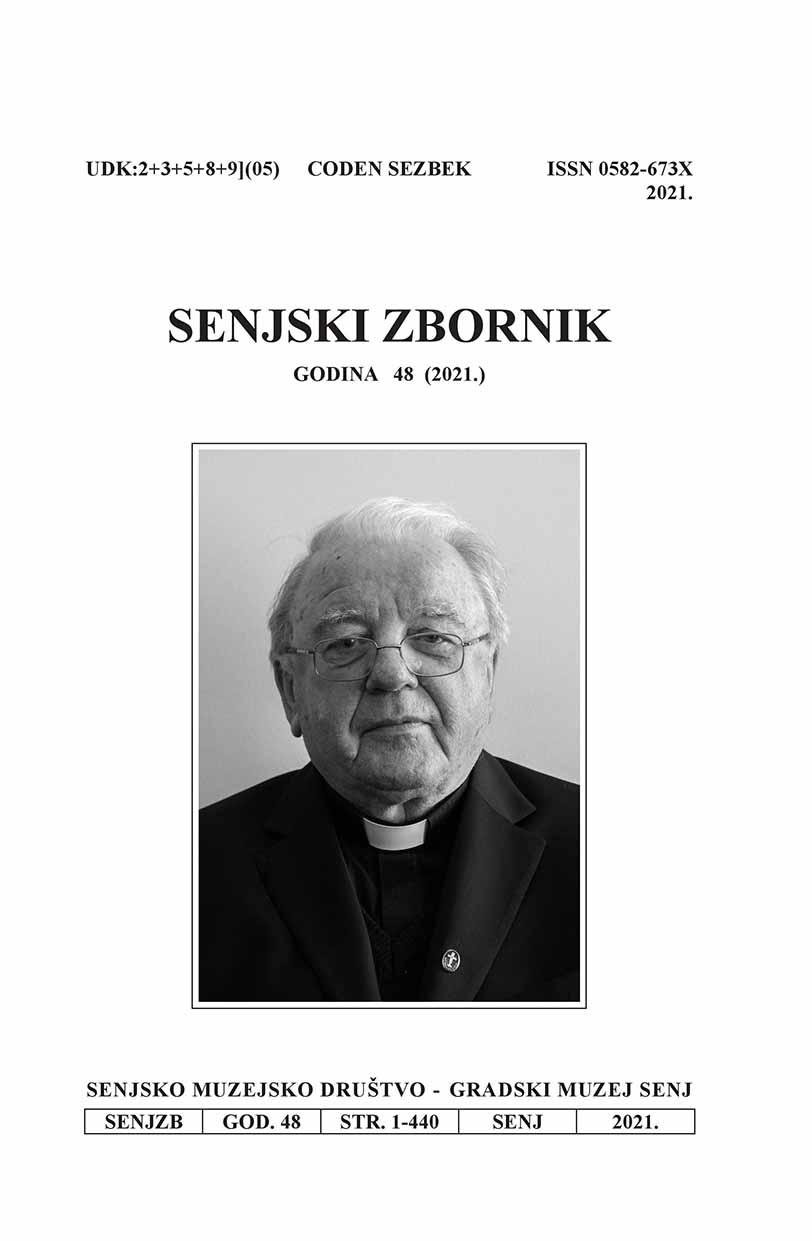CRTICE O ZAPRETENOJ SENJSKOJ BAŠTINI SREDNJEGA VIJEKA U KONTEKSTU UMJETNOSTI ISTOČNOJADRANSKE OBALE I OTOKA
OUTLINES ABOUT SENJ’S HIDDEN HERITAGE OF THE MIDDLE AGES IN THE CONTEXT OF THE ARTS OF THE EASTERN ADRIATIC COAST AND ISLANDS
Author(s): Marijan BradanovićSubject(s): Archaeology, Museology & Heritage Studies, Architecture, Preservation, Comparative history, Local History / Microhistory, Middle Ages, History of Art
Published by: Senjsko muzejsko društvo i Gradski muzej Senj
Keywords: Senj; cultural heritage; urbanism; architecture; Middle Ages; Krk; Rab; Venice; Andrija Aleši;
Summary/Abstract: Senj’s heritage in general is historically and artistically extremely poorly researched and interpreted in the wider context of the heritage of the Eastern Adriatic coast. This is especially true of the monuments of the Middle Ages, hidden under completely different later architectural layers in the Early Modern Age of the militarised town. The examples analysed here are hypothetically interpreted in a new way, with suggestions for the dating and stylistic connections from the region of Kvarner, as well as from the wider Adriatic area. Along with the emphasis on the historical circumstances and the analysis of graphic and written sources, a proposal is presented for the dating and stylistic connection of the destroyed mediaeval tower (in the old Croatian Chakavian dialect - turan) in front of the façade of Senj’s cathedral. The possible closest twin and model to the Senj tower is probably located in Krk - insufficient data about the appearance of the Senj tower requires some speculation. All the circumstances that support such an interpretation, in the stylistic and chronological connection of the former Romanesque bell tower of the Krk cathedral from the end of the 12th century and the bell tower in front of Senj’s cathedral are explained exhaustively. It is assumed that, like the Krk bell tower, this one in Senj also had a communal status, so this may have been the reason for the construction of one more bell tower behind the rear of the cathedral, connected to the whole of the bishop of Senj’s historical residence. After this, two chronologically and epigraphically-palaeographically close inscriptions are compared with two churches from the first half of the 14th century, one which according to A. Glavičić was located on the site of the sacristy of Senj’s cathedral and the other which was located on the site of the sacristy of the Krk cathedral. The epigraphically palaeographically very close inscriptions, Senj’s "Imie od Raduča" and Krk’s which mentions the donors "Leonard" and "Bogdan", as well as the master craftsman "Mikel", are dated just four years apart. Finally, there is a comparative discussion about the process of urbanisation, architecture and the possible original name of Senj’s Mala Placa, the probable centre of the secular communal life of Senj in the late Middle Ages and the second focal point of the then already bicentrically organised town. Also discussed are the implications arising from the existence of such an urban focal point located next to the quay and completely separated from the most important public space in front of the cathedral. A proposal is presented for the dating of the town Loggia (the socalled "Kampuzija") to the 14th century. The term is interpreted as the name of the Loggia (Loža), but also as the name of the whole area regulated early as a square, in the sense of "campo" - like Krk’s Kamplin. The explicit Venetian method of the shaping of the brick-built Loggia, fitted with characteristic ground floor columns and Gothic monophores on the first floor part of the façade, stands out. One’s attention is drawn to its basement storage area which may have been a storeroom for salt. In this way, an early Venetian contribution (14th century) to the urbanisation of this part of the town located in the immediate vicinity of the quay stands out. For the Daničić house fitted with a luxurious late Gothic triforium, it is assumed that in the late Middle Ages it could have been a town hall and that it could, in fact, have been the town hall whose beauty was praised by J. W.Valvasor. A hypothesis is made about its original dimensions. With a little research luck, this could be confirmed by the conservation-restoration research of the inner face of the house’s masonry, especially the floors at the level of the skilfully carved Late Gothic triforium. The triforium is attributed to the work of Andrija Aleši from the 1550s.
Journal: Senjski zbornik - prilozi za geografiju, etnologiju, gospodarstvo, povijest i kulturu
- Issue Year: 48/2021
- Issue No: 1
- Page Range: 187-214
- Page Count: 28
- Language: Croatian

